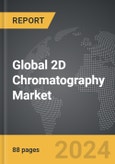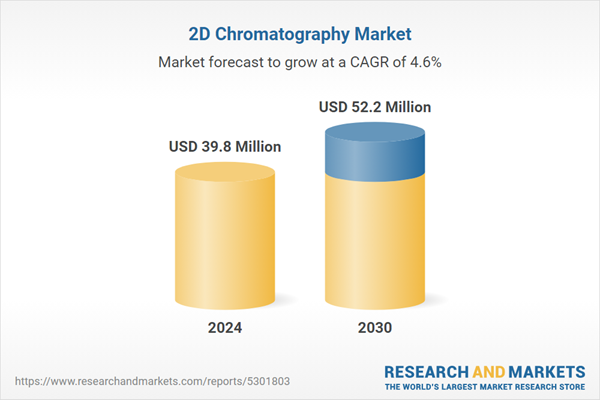The global market for 2D Chromatography was valued at US$39.8 Million in 2024 and is projected to reach US$52.2 Million by 2030, growing at a CAGR of 4.6% from 2024 to 2030. This comprehensive report provides an in-depth analysis of market trends, drivers, and forecasts, helping you make informed business decisions. The report includes the most recent global tariff developments and how they impact the 2D Chromatography market.
Segments: Type (2D Gas Chromatography, 2D Liquid Chromatography); Application (Life Sciences Research, Environmental Analysis, Food & Beverage Testing, Petrochemical & Natural Gas Analysis, Other Applications).
Geographic Regions/Countries: World; United States; Canada; Japan; China; Europe (France; Germany; Italy; United Kingdom; Spain; Russia; and Rest of Europe); Asia-Pacific (Australia; India; South Korea; and Rest of Asia-Pacific); Latin America (Argentina; Brazil; Mexico; and Rest of Latin America); Middle East (Iran; Israel; Saudi Arabia; United Arab Emirates; and Rest of Middle East); and Africa.
The analysts continuously track trade developments worldwide, drawing insights from leading global economists and over 200 industry and policy institutions, including think tanks, trade organizations, and national economic advisory bodies. This intelligence is integrated into forecasting models to provide timely, data-driven analysis of emerging risks and opportunities.
Global 2D Chromatography Market - Key Trends and Drivers Summarized
How Is 2D Chromatography Revolutionizing Complex Sample Analysis?
2D chromatography has emerged as a transformative tool in scientific and industrial research, enabling the detailed separation and analysis of complex mixtures that are often too challenging for traditional one-dimensional methods to resolve. The key advantage of 2D chromatography lies in its ability to perform two successive separations using different chemical or physical principles, such as polarity, charge, or molecular size, which results in much higher resolution. This dual-stage process allows for the separation of hundreds or even thousands of compounds in a single analysis, providing far more comprehensive data. This is particularly valuable in fields like proteomics, metabolomics, and environmental analysis, where biological samples or environmental contaminants can be highly complex, with components that have similar chemical properties. By delivering high-resolution separations, 2D chromatography helps scientists to more accurately identify and quantify compounds in a mixture, leading to greater insights into molecular interactions, biological pathways, and chemical compositions. As research and industrial processes increasingly require detailed analyses of complex mixtures, 2D chromatography is becoming an indispensable tool in fields such as drug discovery, food safety, and environmental monitoring.What Technological Innovations Are Enhancing 2D Chromatography?
Technological innovations are continuously improving the capabilities of 2D chromatography, making it faster, more precise, and better suited to handle the increasing complexity of modern scientific challenges. One of the most impactful developments is the integration of advanced detection systems such as mass spectrometry (MS) and nuclear magnetic resonance (NMR), which provide highly sensitive and accurate identification of compounds at trace levels. The coupling of 2D chromatography with these detection methods enables researchers to not only separate complex mixtures but also gain detailed molecular information about each component, which is critical in fields like pharmaceuticals and biotechnology. Additionally, innovations in column technology have dramatically improved the efficiency and resolution of separations. These columns, designed with advanced materials, can handle higher pressures and offer better separation efficiency, reducing analysis times without sacrificing the quality of results. The introduction of automated and high-throughput systems has further streamlined 2D chromatography workflows, allowing for more samples to be processed in less time while minimizing human error. These systems are supported by sophisticated software that can manage the large datasets produced by 2D chromatography, offering improved data interpretation and easier identification of critical trends. These advancements are not only making 2D chromatography more powerful but also more accessible for routine use in research and industry.Why Are More Industries Adopting 2D Chromatography?
Industries are increasingly turning to 2D chromatography as a solution to meet the growing demand for precise and comprehensive analytical methods. In the pharmaceutical industry, for instance, 2D chromatography is indispensable for drug development, helping researchers to characterize complex drug compounds and identify trace impurities that could affect drug safety and efficacy. As regulatory bodies impose stricter guidelines on the purity and quality of pharmaceuticals, the use of advanced chromatographic techniques like 2D chromatography has become a necessity. The food and beverage industry also relies on this technology to ensure product safety by detecting contaminants and verifying ingredient authenticity. Additionally, environmental testing has greatly benefited from the high sensitivity of 2D chromatography, which can detect trace levels of pollutants and toxic substances in air, water, and soil. As environmental regulations become more stringent, the ability to perform precise, high-resolution analyses is crucial for compliance. Beyond these traditional applications, 2D chromatography is also expanding into emerging fields such as biotechnology and life sciences, where it is used to study complex biological samples like proteins and metabolites. This versatility and the ability to offer deeper insights into sample composition are driving the adoption of 2D chromatography across a wide range of industries.What Factors Are Driving the Growth of the 2D Chromatography Market?
The growth in the 2D chromatography market is driven by several factors, reflecting the increasing need for advanced analytical tools that can keep up with the demands of modern research and industry. One of the main drivers is the growing complexity of the samples that need to be analyzed, particularly in fields like pharmaceuticals, biotechnology, and environmental science. As researchers and industries deal with more sophisticated materials, the limitations of traditional chromatography techniques become more apparent, pushing demand for 2D chromatography’s higher resolution and better separation capabilities. Regulatory pressures are also playing a significant role, especially in sectors like pharmaceuticals and food safety, where companies must meet rigorous standards for purity and contaminant detection. The ability of 2D chromatography to provide detailed, reliable results makes it a key tool for ensuring compliance with these standards. Technological advancements, such as faster, more efficient column materials and enhanced detection methods, have made 2D chromatography more practical and cost-effective, driving wider adoption across industries. Furthermore, the rise of personalized medicine and biologics is creating new opportunities for 2D chromatography, as these fields require precise characterization of complex biomolecules. As industries continue to face new challenges that demand more accurate and comprehensive analytical methods, the market for 2D chromatography is expected to grow, with increasing investments in research and development further fueling innovation and adoption.Report Scope
The report analyzes the 2D Chromatography market, presented in terms of units. The analysis covers the key segments and geographic regions outlined below.Segments: Type (2D Gas Chromatography, 2D Liquid Chromatography); Application (Life Sciences Research, Environmental Analysis, Food & Beverage Testing, Petrochemical & Natural Gas Analysis, Other Applications).
Geographic Regions/Countries: World; United States; Canada; Japan; China; Europe (France; Germany; Italy; United Kingdom; Spain; Russia; and Rest of Europe); Asia-Pacific (Australia; India; South Korea; and Rest of Asia-Pacific); Latin America (Argentina; Brazil; Mexico; and Rest of Latin America); Middle East (Iran; Israel; Saudi Arabia; United Arab Emirates; and Rest of Middle East); and Africa.
Key Insights:
- Market Growth: Understand the significant growth trajectory of the 2D Gas Chromatography segment, which is expected to reach US$35.2 Million by 2030 with a CAGR of a 5.1%. The 2D Liquid Chromatography segment is also set to grow at 3.7% CAGR over the analysis period.
- Regional Analysis: Gain insights into the U.S. market, valued at $10.6 Million in 2024, and China, forecasted to grow at an impressive 7.8% CAGR to reach $11.3 Million by 2030. Discover growth trends in other key regions, including Japan, Canada, Germany, and the Asia-Pacific.
Why You Should Buy This Report:
- Detailed Market Analysis: Access a thorough analysis of the Global 2D Chromatography Market, covering all major geographic regions and market segments.
- Competitive Insights: Get an overview of the competitive landscape, including the market presence of major players across different geographies.
- Future Trends and Drivers: Understand the key trends and drivers shaping the future of the Global 2D Chromatography Market.
- Actionable Insights: Benefit from actionable insights that can help you identify new revenue opportunities and make strategic business decisions.
Key Questions Answered:
- How is the Global 2D Chromatography Market expected to evolve by 2030?
- What are the main drivers and restraints affecting the market?
- Which market segments will grow the most over the forecast period?
- How will market shares for different regions and segments change by 2030?
- Who are the leading players in the market, and what are their prospects?
Report Features:
- Comprehensive Market Data: Independent analysis of annual sales and market forecasts in US$ Million from 2024 to 2030.
- In-Depth Regional Analysis: Detailed insights into key markets, including the U.S., China, Japan, Canada, Europe, Asia-Pacific, Latin America, Middle East, and Africa.
- Company Profiles: Coverage of players such as Agilent Technologies, Bio-Rad Laboratories, Danaher, Leco, Merck KGaA and more.
- Complimentary Updates: Receive free report updates for one year to keep you informed of the latest market developments.
Some of the 32 companies featured in this 2D Chromatography market report include:
- Agilent Technologies
- Bio-Rad Laboratories
- Danaher
- Leco
- Merck KGaA
- Restek
- Sepsolve Analytical
- Shimadzu
- Thermo Fisher Scientific
- Waters
Tariff Impact Analysis: Key Insights for 2025
Global tariff negotiations across 180+ countries are reshaping supply chains, costs, and competitiveness. This report reflects the latest developments as of April 2025 and incorporates forward-looking insights into the market outlook.The analysts continuously track trade developments worldwide, drawing insights from leading global economists and over 200 industry and policy institutions, including think tanks, trade organizations, and national economic advisory bodies. This intelligence is integrated into forecasting models to provide timely, data-driven analysis of emerging risks and opportunities.
What’s Included in This Edition:
- Tariff-adjusted market forecasts by region and segment
- Analysis of cost and supply chain implications by sourcing and trade exposure
- Strategic insights into geographic shifts
Buyers receive a free July 2025 update with:
- Finalized tariff impacts and new trade agreement effects
- Updated projections reflecting global sourcing and cost shifts
- Expanded country-specific coverage across the industry
Table of Contents
I. METHODOLOGYII. EXECUTIVE SUMMARY2. FOCUS ON SELECT PLAYERSIII. MARKET ANALYSISSOUTH KOREAREST OF ASIA-PACIFICARGENTINABRAZILMEXICOREST OF LATIN AMERICAIRANISRAELSAUDI ARABIAUNITED ARAB EMIRATESREST OF MIDDLE EASTIV. COMPETITION
1. MARKET OVERVIEW
3. MARKET TRENDS & DRIVERS
4. GLOBAL MARKET PERSPECTIVE
UNITED STATES
CANADA
JAPAN
CHINA
EUROPE
FRANCE
GERMANY
ITALY
UNITED KINGDOM
SPAIN
RUSSIA
REST OF EUROPE
ASIA-PACIFIC
AUSTRALIA
INDIA
LATIN AMERICA
MIDDLE EAST
AFRICA
Companies Mentioned (Partial List)
A selection of companies mentioned in this report includes, but is not limited to:
- Agilent Technologies
- Bio-Rad Laboratories
- Danaher
- Leco
- Merck KGaA
- Restek
- Sepsolve Analytical
- Shimadzu
- Thermo Fisher Scientific
- Waters
Table Information
| Report Attribute | Details |
|---|---|
| No. of Pages | 88 |
| Published | April 2025 |
| Forecast Period | 2024 - 2030 |
| Estimated Market Value ( USD | $ 39.8 Million |
| Forecasted Market Value ( USD | $ 52.2 Million |
| Compound Annual Growth Rate | 4.6% |
| Regions Covered | Global |









